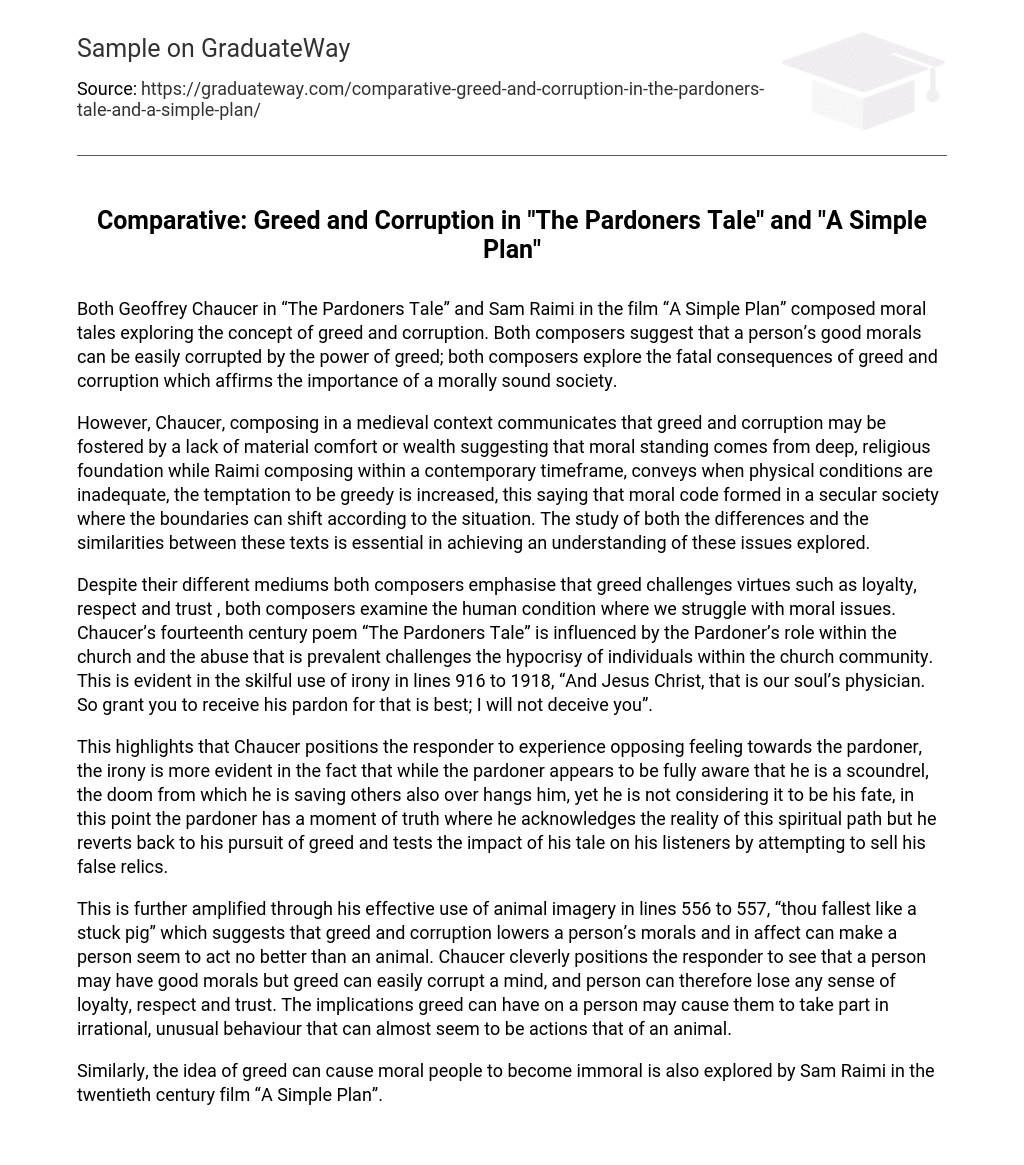Both Geoffrey Chaucer in “The Pardoners Tale” and Sam Raimi in the film “A Simple Plan” present moral tales that delve into the theme of greed and corruption. They both convey the idea that greed has the ability to corrupt a person’s morals, and they both examine the catastrophic outcomes that result from succumbing to greed and corruption. This reinforces the significance of upholding a society with strong moral values.
However, Chaucer conveys in a medieval context that greed and corruption can arise from a lack of material comfort or wealth, suggesting that moral standing comes from a deep religious foundation. On the other hand, Raimi, composing within a contemporary timeframe, suggests that when physical circumstances are inadequate, the temptation to be greedy increases. This implies that moral code is formed in a secular society where boundaries can shift depending on the situation. Therefore, studying both the differences and similarities between these texts is crucial in understanding the issues they explore.
Despite the different mediums, both composers explore the theme of greed undermining virtues like loyalty, respect, and trust. They also examine the human condition, where individuals struggle with ethical dilemmas. In Chaucer’s 14th-century poem “The Pardoner’s Tale,” the Pardoner’s role within the church and the prevalent abuse challenge the hypocrisy of individuals within the church community. This hypocrisy is skillfully portrayed through irony in lines 916 to 1918: “And Jesus Christ, that is our soul’s physician. So grant you to receive his pardon for that is best; I will not deceive you.”
Chaucer’s manipulation of the responder is apparent in their conflicting emotions towards the pardoner. The irony lies in the pardoner’s self-awareness as a scoundrel, yet he fails to recognize the impending doom that also awaits him. This moment of truth forces the pardoner to acknowledge the spiritual consequences of his actions, but he quickly reverts back to his greed-driven pursuit and tests the reaction of his audience by attempting to sell his fraudulent relics.
Chaucer effectively uses animal imagery in lines 556 to 557, stating that someone “fallest like a stuck pig,” to emphasize how greed and corruption can degrade a person’s morals, making them behave like animals. Chaucer’s intention is to show that greed can easily corrupt even someone with good morals, causing them to lose loyalty, respect, and trust. The consequences of greed can push individuals to engage in irrational and unusual behavior, appearing more like wild animals than civilized humans.
Sam Raimi explores the concept of greed causing moral individuals to become immoral in his 20th century film “A Simple Plan”. The film’s portrayal of greed and corruption is heavily influenced by the temporal concerns of secular society. This can be observed in the scene where Sarah is being framed in the bookshelf.
Here, the filmmaker employs an extreme close-up to convey the impression to the viewer that nothing has altered. However, the reality is that due to the characters’ overwhelming greed, their lives have undergone substantial transformations. This effect is further accentuated through the clever utilization of voice-over, particularly in the mill scene where Hank’s retrospective narrative offers an explanation of the events and maintains the illusion of constancy while in fact life has significantly changed. The film effectively positions us to comprehend the malevolence and transformative impact that greed can have.
Both Chaucer and Raimi suggest that everyone has the ability to be wicked and dishonest. However, there are differences in their perspectives. Chaucer believes that greed and corruption can exploit goodwill and take place in a spiritual context, as exemplified by the characters’ journey to a shrine in Canterbury. On the other hand, Raimi argues that greed and corruption can lead to various forms of evilness, causing even good and innocent individuals to become immoral. Chaucer wrote during the fourteenth century when corruption within the church, which should promote honesty, was prevalent. In contrast, Raimi wrote during the twentieth century when society was more focused on worldly matters that are temporary rather than spiritual ones.
Chaucer examines the concept that storytelling has a corrupting influence in The Pardoner’s Tale. Through the clever use of emotive language, he skillfully manipulates the audience, creating a straightforward and impactful narrative that elicits the same emotions experienced by the characters in the story. This immersive approach effectively involves the audience in a journey of corruption, engendering a profound and bewildering emotional response.
In contrast, Sam Raimi shows that the viewer becomes complicit in the corruption. This can be seen in the effective use of extreme close-up in the scene featuring the fox and the crow, who are depicted as predators. This reflects the association of death and cunningness with these stereotypical animal traits, and how the innocent nature of the characters is later tainted by immoral actions. Raimi positions the viewer to acknowledge that one’s moral values can be corrupted by greed and lead to malevolent intentions.
While Chaucer indicates that individuals who are inherently evil will be easily enticed by greed, both Geoffrey Chaucer and Sam Raimi depict greed and corruption to remind the audience of the dire repercussions they can have, highlighting the significance of a morally upright society. However, Chaucer emphasizes that a strong moral compass stems from a profound religious base, whereas Raimi suggests that moral principles are shaped within a non-religious society where boundaries can flex depending on the circumstances. Despite their contrasting contexts, both viewpoints offer valuable insights and remain pertinent.





